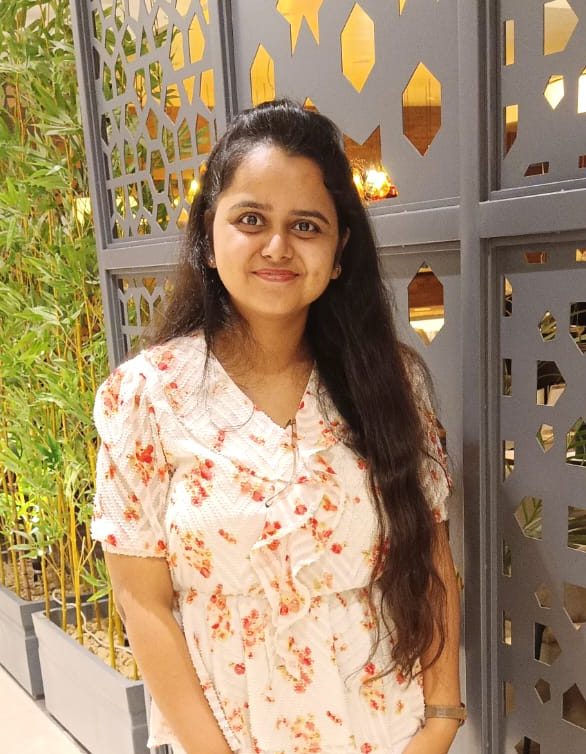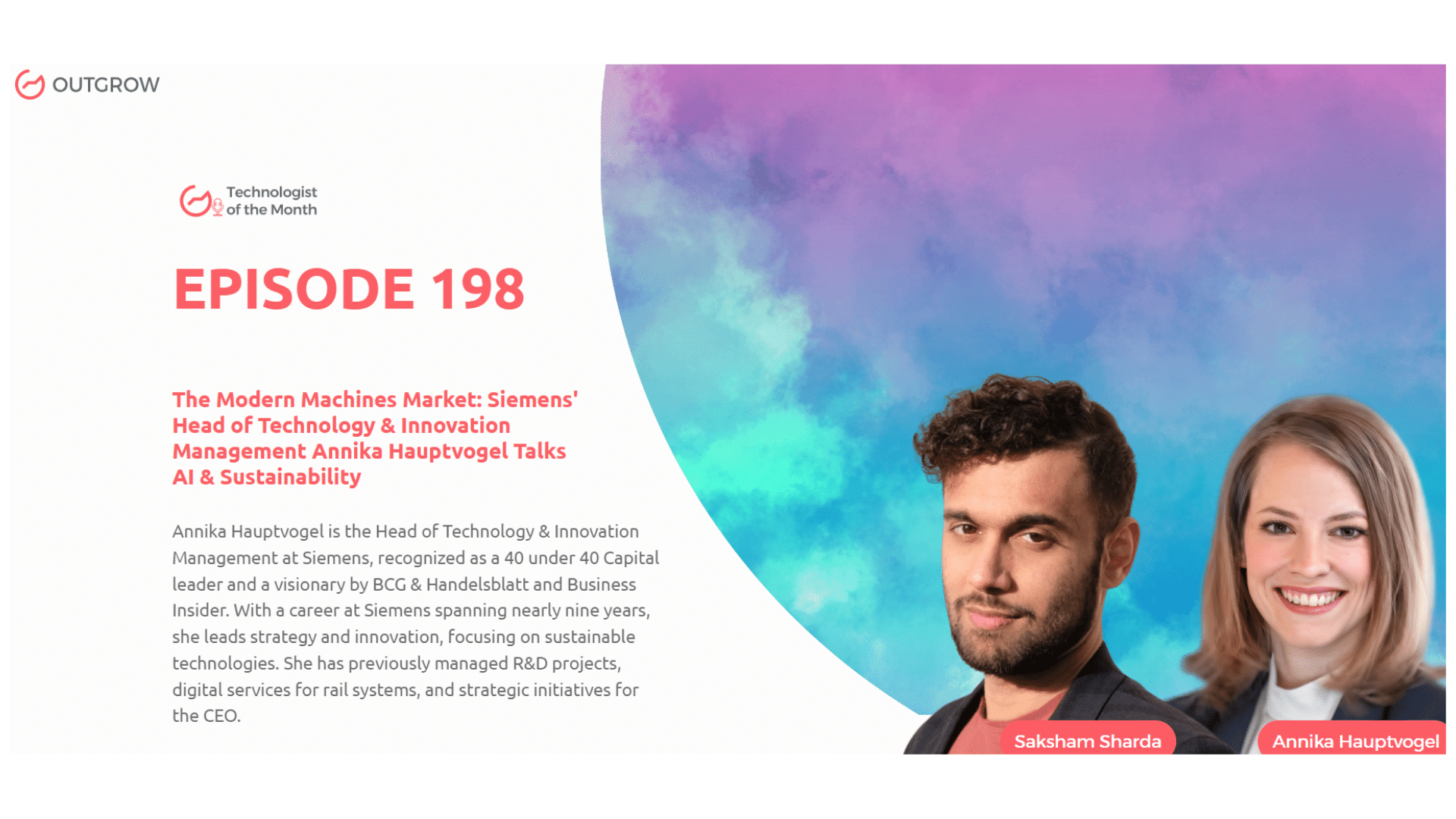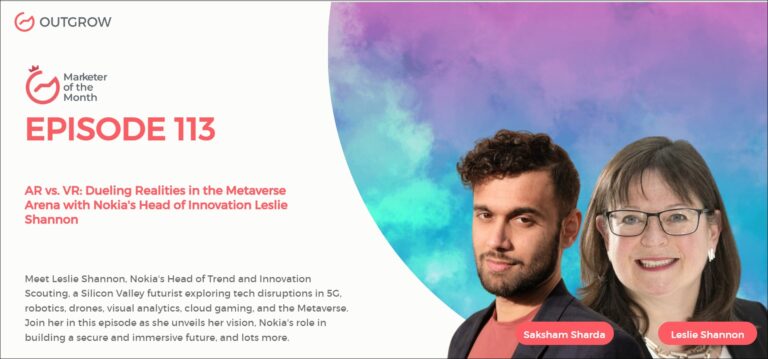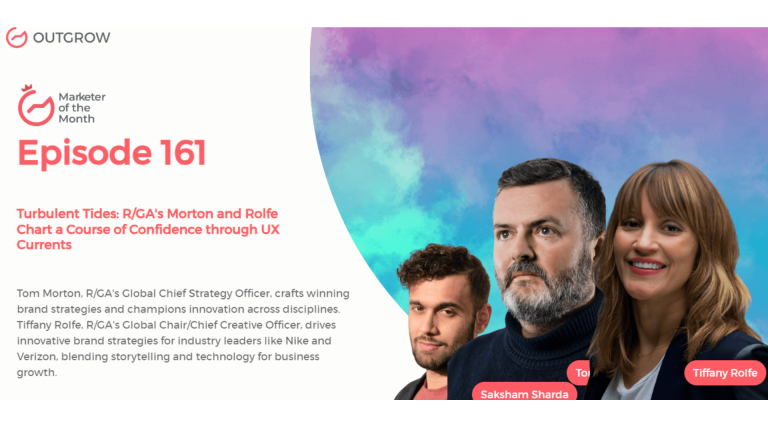EPISODE 198: Marketer of the Month Podcast with Joshua Tucker
Table of Contents
Hey there! Welcome to the Marketer Of The Month blog!
We recently interviewed Annika Hauptvogel for our monthly podcast – ‘Marketer of the Month’! We had some amazing insightful conversations with Annika and here’s what we discussed about –
1. Describes how KPIs are important for measuring the success of industrial metaverses.
2. Reassures the positive impact of AI on jobs and the workforce.
3. Overview of the innovation ecosystem and its impact on fostering collaboration.
4. Details on external partnerships and open innovation campaigns.
5. Approach to handling technical regulations, standardization, and quality management.
6. Describes Siemens’ marketing strategy aligned with business goals.
7. Addresses challenges and solutions in managing innovation in a large organization.
About our host:
Dr. Saksham Sharda is the Chief Information Officer at Outgrow.co. He specializes in data collection, analysis, filtering, and transfer by means of widgets and applets. Interactive, cultural, and trending widgets designed by him have been featured on TrendHunter, Alibaba, ProductHunt, New York Marketing Association, FactoryBerlin, Digimarcon Silicon Valley, and at The European Affiliate Summit.
About our guest:
Annika Hauptvogel is the Head of Technology & Innovation Management at Siemens, recognized as a 40 under 40 Capital leader and a visionary by BCG & Handelsblatt and Business Insider. With a career at Siemens spanning nearly nine years, she leads strategy and innovation, focusing on sustainable technologies. She has previously managed R&D projects, digital services for rail systems, and strategic initiatives for the CEO.
The Modern Machines Market: Siemens’ Head of Technology & Innovation Management Annika Hauptvogel Talks AI & Sustainability
The Intro!
Saksham Sharda: Hi, everyone. Welcome to another episode of Outgrow’s Marketer of the Month. I’m your host, Dr. Saksham Sharda, and I’m the creative director at Outgrow. co. And for this month we are going to interview Annika Hauptvogel who is the Head of Technology & Innovation Management, at Siemens.
Annika Hauptvogel: Great to be here. Thank you.
Don’t have time to read? No problem, just watch the Podcast!
Challenge yourself with this trivia about the exciting topics Annika Hauptvogel covered in the podcast.
Or you can just listen to it on Spotify!
The Rapid Fire Round!
Saksham Sharda: Okay, so you’re gonna start with the rapid-fire round. You can only answer with one word or one sentence, okay? Okay. Alright. So the first one is, at what age do you want to retire?
Annika Hauptvogel: Oh, at 60.
Saksham Sharda: How long does it take you to get ready in the mornings?
Annika Hauptvogel: One hour.
Saksham Sharda: Pass. Favorite color?
Annika Hauptvogel: Blue.
Saksham Sharda: What time of day are you most inspired?
Annika Hauptvogel: In the evening.
Saksham Sharda: How many hours of sleep can you survive on?
Annika Hauptvogel: Five.
Saksham Sharda: Fill in the blank. An upcoming technology trend is ____.
Annika Hauptvogel: Artificial general intelligence.
Saksham Sharda: Pick one. Mark Zuckerberg or Elon Musk.
Annika Hauptvogel: Elon Musk.
Saksham Sharda: How do you relax?
Annika Hauptvogel: By skiing.
Saksham Sharda: How many cups of coffee do you drink per day?
Annika Hauptvogel: One.
Saksham Sharda: The most valuable skill you’ve learned in life?
Annika Hauptvogel: To create your network before you need it.
Saksham Sharda: One-word description of your leadership style.
Annika Hauptvogel: Collaborative.
Saksham Sharda: Ideal vacation spot for relaxation.
Annika Hauptvogel: The mountains.
Saksham Sharda: Key factor for maintaining a work-life balance.
Annika Hauptvogel: To be structured.
Saksham Sharda: Memorable career milestone.
Annika Hauptvogel: Taking over the current position as head of technology and innovation management.
The Big Questions!
Saksham Sharda: Alright, well that was the end of the rapid-fire round. Let’s go on onto the longer questions, which you can answer with as much time and ease as you like. The first one is, can you share some insights into the key objectives and priorities of the technology and innovation management department within Siemens?
Annika Hauptvogel So, as head of technology and innovation management, I’m the innovation enabler for Siemens. So we try to understand what the future looks like in terms of what the most important technology trends are and which of them are relevant to Siemens. We also think about how we can develop those technologies already today so that we can transfer those into the next generation of our products and then finally into the markets.
Saksham Sharda: And so how have these objectives evolved over the past few years in response to changing market demands and technological advancements?
Annika Hauptvogel: The speed that we have to reach has increased over the past years. So our main goal is the transfer of technologies from pre-development into our businesses, into our products. And because innovation cycles are getting shorter and shorter, we have to become faster and faster to transfer from pre-development into product development.
Saksham Sharda: And so how does your department contribute to shaping Siemens’ overarching technology strategy and roadmap in this regard?
Annika Hauptvogel: So we look into the future, we try to understand the most important technology trends and we identify those that are relevant to Siemens. So to give you one example, the industrial metaverse was a major topic three years, four years ago. We said that is super relevant to Siemens as our strategy is to combine the real anti-digital world. So just by seeing this as an opportunity, of course, nothing is done. We implemented this in our company core technologies so that the people, the researchers already started developing the industrial metaverse for Siemens and now you can apply it. So that is just one example of how we went from identifying a trend into bringing it to the market.
Saksham Sharda: And what are the ways in which it’s being used in Siemens right now?
Annika Hauptvogel: So the industrial metaverse is, as I said, combining the real and digital world. So for example, we have the replication of a factory and that is something we can do in our factories. So there’s one in Germany, in an airline, and for example, where we have the industrial metaverse of this factory that helps us to understand the processes and to optimize the processes within the factory. So it’s, if you look, it’s the industrial metaverse. It’s a replication of what is going on in the real world, but it’s not only relevant in our factories, it’s of course also relevant to our customers because they also have factories. And so they apply what we have already tested in our factory.
Saksham Sharda: And so what are some of the key metrics or indicators you use to measure the success of these industrial metaverses in the technology strategy?
Annika Hauptvogel: I mean, it’s successful when it’s implemented. These examples I’ve mentioned, show that it’s already there, not only in our factory as a kind of customer zero, but also in the external world. And to make it successful. It’s not just by implementing. I mean that’s maybe easy, but we now see that with the industrial metaverse, we are able to save energy. We can increase productivity and therefore just one example we had two different factories and wanted to combine them in a new factory site. So there we were able to measure the productivity in the old factories and compare this with the new factory that was created, designed, tested, and optimized in the industrial metaverse. And we can now see as this new factor is built that we have a productivity increase of 20%. So this shows that the technology by itself is really helpful. And this is can, this is a KPI to show the success of the industrial metaverse.
Saksham Sharda: And so could you elaborate on the role of the technology and innovation management department in driving and supporting company care technologies at Siemens?
Annika Hauptvogel: Yeah, so in Siemens we have defined 11 company core technologies that are relevant to the whole Siemens organization. We invest around about 500 million per year in developing those technologies further. Just some examples. Artificial intelligence is one, so everyone knows ChatGPT. But we already started in 2016 working on large language models. We applied for GPT two and so on. So that is what we do in those companies’ core technologies, really working on the technologies before they can be applied in reality or in industry.
Saksham Sharda: And how do you identify and prioritize which core technologies to focus on?
Annika Hauptvogel: Well, by doing foresighting, by trying to understand what is the, what does the future look like? Not only from a technology perspective but of course also from a geopolitical perspective, from a customer perspective. That is all these aspects are very relevant if you identify the technologies that are relevant to Siemens because, in the end, I think a technology is only successful if it’s part of a product or service and if it’s successful in the market, and can be applied.
Saksham Sharda: So what are some notable innovations or initiatives that have stemmed from your department’s efforts in technology and innovation management that have been successful in the market?
Annika Hauptvogel: The industrial metaverse is our major topic right now. Demands combines the real and the digital world and the industrial mid-Evers is exactly doing this. I’ve already talked about factories, but it’s also relevant in the design phase. And to give you one example, if you think about designing a new product, of course, you can already do this in a virtual environment, in a 2D environment, but with the industrial metaverse, you’re able to try out this product in this virtual environment because you can also simulate the whole environment where the product will be used and applied in its life cycle. Therefore you don’t have to do the prototyping in the real world, but you can just do it in this virtual environment and therefore you not only save time and costs, but also material. And that has a huge impact on sustainability. If I lose my way, use way more less resources. So we say we can now save up to 50% of resources just by doing this prototyping in a virtual environment in the industrial metaverse.
Saksham Sharda: And are there any other upcoming initiatives that you’re particularly excited about?
Annika Hauptvogel: Well, if I look into the far future of course AI will still be a major topic, but also artificial general intelligence. So now AI is as good as we train it, but at some point in time, and I think that’s not coming in the next one, two or three years, but at some point in time, AI will be as intelligent as we are as human beings and this will have a major impact. For example, at Siemens, we also manufacture trains. They are already autonomous in certain areas, but really to make a train or even a car, an autonomous system, you need to have this kind of intelligence. And so this will then be again, a major step forward, in terms of technology and also its application in the market.
Saksham Sharda: Should people be afraid of that?
Annika Hauptvogel: No, definitely not. I mean, what has shown us the technologies in general over the years, I mean people were afraid of robots because they said, I will lose my job because the robot will do my job. But what we see today is that we have a lack of skilled workforce. So we need not only robots but also artificial intelligence to be able to do the jobs that are out there and that is maybe repeatable, boring, and so on. So jobs that people don’t want to do on their own. And that’s why I think we shouldn’t be afraid, but rather see it as a positive opportunity for us as human beings to make our lives way easier.
Saksham Sharda: So the Siemens innovation ecosystem, let’s talk a bit about that seems like a significant initiative. Can you discuss how it operates and its impact on fostering innovation within the company?
Annika Hauptvogel: Yeah, so the Siemens innovation ecosystem was launched four years ago because we realized we do have a lot of experts in Siemens, for example, AI experts. They are in different organizations, but if they do not know each other, they cannot share their experiences, and they cannot learn from each other. So we said we need a platform where we bring together all the people in Siemens that work on innovation, that work on new technologies, and that was the first idea for this Siemens innovation ecosystem. What we realized though is just by launching that kind of platform, you don’t necessarily bring the people on that platform. So we had to think about how we could motivate our colleagues to join us on this platform. And that’s why we started to offer campaigns. So we put different challenges on that platform so that people then can bring in their ideas and then the best ones they will be able to develop further. And now we have more than 100,000 people within the Siemens organization in the Siemens innovation ecosystem. So it’s more than 30% of the whole Siemens team that is using this platform. And so that’s a great success for us showing that we have those entrepreneurs in our company.
Saksham Sharda: So it facilitates both collaboration and knowledge sharing amongst different departments and also external partners?
Annika Hauptvogel: On the Siemens innovation ecosystem. Yes, absolutely. It’s knowledge sharing and developing new great ideas. Furthermore, we also learned that, I mean the number of participants is limited if we keep this internal. So that’s why we decided to offer the same Siemens innovation ecosystem also to the external world. So it’s on Siemens ecosystems where you can then also as an external partner participate. Both systems are separated, I mean due to IP reasons and so on. But the setup is similar. So we also have a lot of campaigns on this platform where students and startups can join us and bring in their ideas. We do have, for example, a tech for sustainability campaign. And the idea behind that is we ask our businesses, what is your main challenge in regards to sustainability? And we make sure that this challenge is described in very detail because only then you will find the right partner in the external world. This is something I’m very proud of because we already had three attacks for sustainability campaigns that generated a lot of great ideas that are now developed further within Siemens.
Saksham Sharda: Speaking about sustainability and regulations in general, then how does your department approach the governance of technical regulation, standardization, and quality management within the Siemens technology landscape?
Annika Hauptvogel: So when you want to be successful in the market you also have to of course be able to apply those technical regulations that are out there. What we do today is also helping those standards, and those technical regulations evolve in the right direction. So I’ve talked a lot about the industrial metaverse and there is, for example, the Metaverse standards forum in us. So as Siemens, we participate in this forum to help drive standardization for the industrial metaverse. And the thing about the industrial metaverse is not to develop new regulations and new standards, but rather look at what is already out there. So there are a lot of standards that we can apply for as industrial metaverse and only if we identify some gaps then we should think about the next regulations or the next standards. So I think that is an important aspect when we talk about technical regulation. To not come up with the next regulation and the next act and so on would rather take what is there and develop those further.
Saksham Sharda: And so with the rapid pace of technological change, I assume making tech regulation is also hard. How does your team stay ahead of emerging trends and disruptions to inform Siemens technology strategy effectively?
Annika Hauptvogel: So what we do, I mean there’s no magic behind it. We look at what is out there, what Gartner says, world economics, foreign Bank of America, all the different sources. We also do a lot of expert interviews to understand what they think about the technology of the future. And from that, we derive a radar. We have roughly 250 technology trends on that radar, and of course, it’s continuously updated and then we look at all the technologies and understand which of them are relevant to Siemens. For example, immortality is something that is a huge topic in Silicon Valley, but it’s not that relevant to Siemens. So then we look at those that are relevant to us, roundabout 100, 150, and then we map this to what we already do. I mean like industrial mid areas, we can make a check mark. And then there are others where we do not have activities today in our company core technologies. And then we work closely together with our strategy department because they understand the market. And then bringing those aspects of technology the push on the market pulls together and then we identify the relevant technologies where we then dive deeper and eventually already start the development today.
Saksham Sharda: So speaking of the market then, can you describe your overall marketing strategy and how it aligns with your company’s business goals?
Annika Hauptvogel: So at Siemens, our goal is to combine the real and enter the digital world. And as a tech company to develop technology with purpose, means that all our solutions, all the technology we develop, serve a specific challenge in our daily lives. So for example, if you traveled by train to Viva Tech, you might have taken a Siemens train. If you’re in a building, maybe there is Siemens automation included. So we always think about the purpose that we serve with our own technology. As I’m part of Siemens technology, of course, that is super relevant to us to always think about how the technology we develop today can have an impact on our daily lives in the future.
Saksham Sharda: So looking ahead, what do you see as the future direction or focus areas for the technology and innovation management department at Siemens?
Annika Hauptvogel: So us as a department it’s very important to always think ahead, and stay ahead. And therefore of course we also have to apply what is out there in our department. So for example crowdsourcing is a major topic when you talk about innovation management. And so bringing all the great minds together and, and finding new ideas. But now with things like chatGPT that might shift. So why don’t you need a huge crowd when you just can ask for ChatGPT, for example, or co-pilot, they will also change the way we drive innovation. How we identify innovation. And I think that is very important to us as a technology and innovation management department to also apply the technologies in our own daily work to also be able to stay ahead.
Saksham Sharda: And are there any challenges that your department faces in managing technology and innovation within such a large and diverse organization like Siemens?
Annika Hauptvogel: Being able to create innovations is of course something where we want to collaborate, where we want to bring the people together within an organization like Siemens. But the good thing at Siemens is that everybody understands that due to the fact that speed is increasing, we really need to collaborate and, and bring people together. So for example, we have an entrepreneur’s boot camp where we bring together different colleagues from different departments so that they can learn the skills you need to be an entrepreneur within a company like Siemens. So we know what the challenges are, but we also have the answers and help people, to get those skills and to be able to innovate in a large organization at Siemens.
Saksham Sharda: So this is a more fun question. What does your typical day at Siemens look like? You wake up in the morning and then?
Annika Hauptvogel: I wake up in the morning and then I don’t know what’s going on. No, I mean every day is a little bit different because in my job of course I have to have a broad view across all the technologies from AI to simulation to also circularity. At the same time as we want to develop the technologies for our businesses, I also have to understand our businesses in mobility, in building in grids, and also in factories what they do and what they need. So therefore, of course, I have to have this broad view and connect all the dots, within Siemens, but also, with the external world, as you said, we are also responsible for technical regulation and we also have to find the right people outside of Siemens and bring everyone together.
Saksham Sharda: So the last question is of a personal kind, what would you be doing in your life, if not this?
Annika Hauptvogel: Well, I would be a ski instructor. I think because I mean, I love being out there in the mountains, being in nature and doing sports. And at the same time, I think being a ski instructor is also a great leadership skill because you have to make sure that a group of people you have for that day, that they follow you, and that they trust you because otherwise, they wouldn’t follow you down the mountain. And you also have to ensure that they have a great day. You know, sometimes it’s cloudy, it’s cold, you don’t really wanna ski, but as a ski instructor, it’s your job to make their day the best skiing day of their vacation. And I think that is something that is also very relevant in my job right now. And, and something that I like about my job is empowering people, trusting people, and bringing them to the next level. So yeah, I think being a ski instructor would also be a nice opportunity.
Let’s Conclude!
Saksham Sharda: Thanks, everyone for joining us for this month’s episode of Outgrow’s Marketer of the Month. That was Annika Hauptvogel who is the Head of Technology & Innovation Management, at Siemens.
Annika Hauptvogel: Pleasure. Thanks for having me.
Saksham Sharda: Check out the website for more details and we’ll see you once again next month with another marketer of the month.

Muskan is a Marketing Analyst at Outgrow. She is working on multiple areas of marketing. On her days off though, she loves exploring new cafes, drinking coffee, and catching up with friends.








